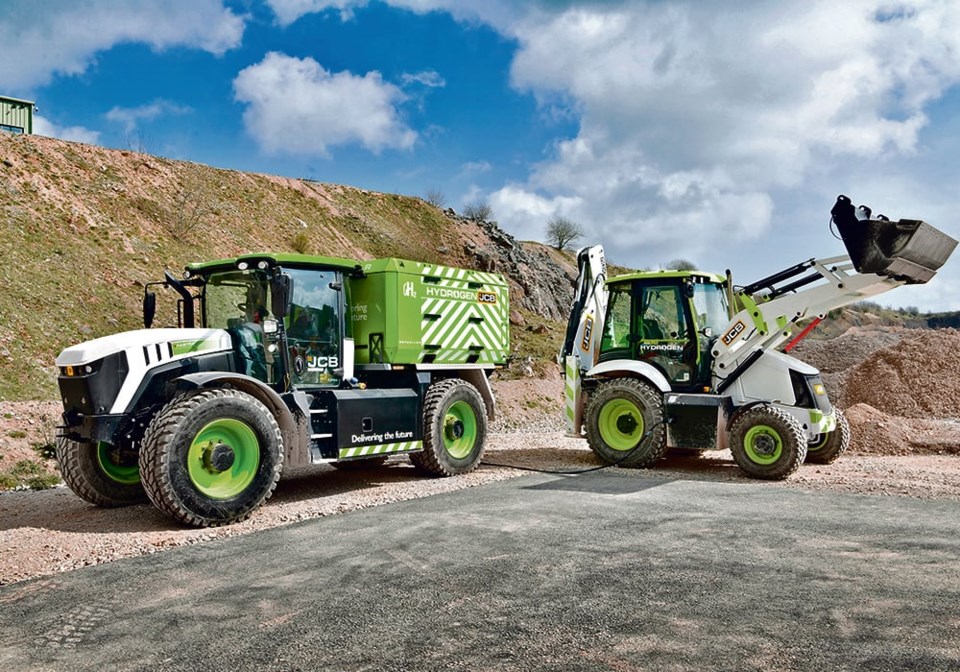WESTERN PRODUCER — Multiple companies are working on hydrogen-powered agricultural equipment, but supporting infrastructure needs to be built before significant adoption of this emerging technology is possible.
JCB Power Systems decided to look upon this problem as an opportunity, and it designed a mobile hydrogen refuelling unit that can transport hydrogen on farms and construction sites.
Chris Giorgianni of JCB said the company builds electric powered construction machines, including an excavator and a forklift, but as machines get bigger the space requirement for the batteries becomes difficult to provide.
The need to transport electric machines to charging stations can also be a problem.
“Right now, you’ll see some job sites where you’ve got an electric vehicle being charged by a generator that runs on diesel,” Giorgianni said.
“As we start getting to the bigger products, electric is not the answer.”
He said JCB concluded hydrogen powered equipment will play a significant role in reducing emissions from both medium and large size heavy equipment.
Engineers at the JCB engine factory in Derbyshire, United Kingdom, developed a hydrogen motor by adapting its engine technology to deliver power the same way diesel engines do.
“We have all this investment and machinery available for blocks, crankshafts, pistons, all that stuff being common. Let’s not ditch all that and start with a whole new power structure like you might do with a fuel cell or anything else,” Giorgianni said.
“Let’s try to find a way to create a different intake system and combustion process that still moves the pistons and still moves the crankshaft the same way it moves today, but with just a different firing mechanism.”
The company has already fitted a prototype backhoe, a Loadall telescopic handler and an excavator with its hydrogen engine.
“The performance that they’ve been able to get is satisfactory, and in some cases better than what they would have experienced with diesel,” Giorgianni said.
Hydrogen is stored in the machines as gas under high pressure, which is stepped down to lower pressure when injected into the engine.
JCB’s combustion process involves lowering the pressure and temperature within the engine to give a clean burn and a zero-emission product, while delivering the same power and torque as a diesel engine.
Giorgianni said the technology is far less complicated than hydrogen fuel-cell technology, and only steam is emitted from the tailpipe of the JCB prototypes.
However, more infrastructure that supports hydrogen equipment is needed, which is why JCB outfitted its Fastrac tractor with a unique hydrogen refueling station.
“You’ve got a Fastrac tractor, in this case as an example, that will run 45 m.p.h. So, you can run to farm sites pretty quickly to refuel and then get out back to whatever tractor or machinery runs on hydrogen,” Giorgianni said.
He said the hydrogen refuelers mimic what farmers do today when filling their machines with diesel, so it won’t be a major disruption to their operation.
The JCB hydrogen refueling unit stores hydrogen in cylinders, and operators will use its nozzle to fill up their hydrogen-powered machine within a few minutes.
The refuelling units can refuel a JCB machine up to 16 times before needing to be recharged.
“We’re in the prototype phase. We have machines running right now, but one of the other challenges is the need for more producers of green hydrogen,” said Shane Coates of JCB.
Engine emissions legislation is much tighter in the U.K.
“We’re still crawling here (North America) right now, and it’s going to take some time because we need to drive the cost down for green hydrogen, and to have more areas where you can attain it,” Coates said.
Giorgianni said JCB has been able to quickly pivot and devote so many resources to developing hydrogen-based products because there is only one shareholder to answer to.
“A lot of our competitors are answering to boards, and some are publicly traded and they’re looking for the return here, now,” Giorgianni said.
“Our owner, Lord Bamford, is looking at the long game by looking at both sides: the power of the machines but also getting the fuel to the machine. So, I think being a privately held company gives us a unique advantage.”

